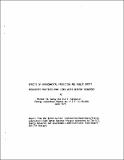Effects of environmental protection and public safety regulatory practices upon light water reactor economics
Author(s)
Golay, Michael Warren.; Saragossi, Isi Isaac.
DownloadMIT-EL-78-009-04766471.pdf (8.471Mb)
Metadata
Show full item recordAbstract
Submitted to the Department of Nuclear Engineering On May 16, 1978 in partial fulfillment of the requirements for the Degree of Master of Science in Nuclear Engineering.
While there is a consensus regarding the need for extensive regulation of the nuclear power industry, the regulatory process has been the subject of almost constant controversy during
recent years. Those subject to regulation complain that regulation is inefficient, that it causes unnecessary licensing and construction delays, and costs; the opponents of nuclear power charge that regulation is inadequate.
This study is an effort to evaluate the performance of the regulatory process to which nuclear power plants are subject.
The study is subdivided into three parts.
Part one presents an analysis of the effects of regulation upon the leadtime and costs of Nuclear Power Plants in the United States. Licensing and construction delays and power plant cost increases caused by regulatory decisions during the past decade are evaluated.
Part two is a brief review of the evolving differences between nuclear power plants and its main rival for base load generation, coal-fired plants, from the viewpoint of the electric utility planners.
Finally, in Part three, the fundamental problems of the current regulatory process are assessed, and suggestions regarding
how to address these problems are presented.
The study is based on a survey of electric utility companies and on data available in the literature.
The findings can be summarized as follows:
1. The liberal rules of the NRC licensing hearings and the lack of coordination between the NRC and state agencies are the major sources of uncertainty in the licensing of nuclear plants;
2. Redesigns and field reworks imposed by the NRC are responsible for an average of 50% of construction delays (15 months);
3. The increasing construction duration, resulting in and increasing amount of interest during construction has been the major cause of the rapid escalation of nuclear plant capital costs in the recent
years. There appears to be a stabilization of the real value (constant dollars, excluding interest during construction) of nuclear plants coming on line after 1973;
4. The historically observed frequent and costly "ratchetings" and "backfittings" of nuclear plants were the inevitable result of the course of commercialization chosen by the industry rather than the consequence of inefficient regulation;
5. The current mix of political and technical issues which must be considered at the level of the NRC in licensing nuclear plants is identified as the major weakness of the current regulatory process;
6. The disparity between the "actuarial" view and the "catastrophic" view of the risks of nuclear energy indicates the need for formal consideration of social values in decision making.
Date issued
1978-06Publisher
MIT Energy Laboratory
Other identifiers
04766471
Series/Report no.
MIT-EL78-009
Keywords
Nuclear power plants |x Licenses |z United States., Nuclear power plants |z United States |x Costs.
Collections
The following license files are associated with this item: